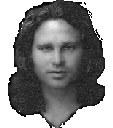| |
Rainer Moddemann (The Doors
Quarterly Magazine)
When descending towards L.A. International Airport, at 3,000 feet the city below presents an
incredible view. Apartment blocks arranged like a chessboard extend to the horizon. Millions of tiny cars
flow down the wide streets and freeways in endless rivers. Small blue patches make one assume that
water also exists amongst the mud-grey slime down there.
Los Angeles is the city of The Doors, and The Doors are and remain inseparably linked to Los
Angeles. Doors fans who get involved in the "Los Angeles Adventure" and spend two afternoons on the
search for historic Doors places with the help of this guide, may soon find out why this city is so
important to the group; and they will feel Jim Morrison's vibes more or less at every other corner. With
the song "L.A.Woman" Jim immortalised this city. Ray Manzarek, John Densmore and Robby
Krieger are still living here. Understandably, I cannot give their private addresses in this context.
For long years West Hollywood used to be the centre of The Doors. Every Doors
tourist should logically start his expedition here; besides, all the Doors sights are in walking distance and
all can be seen within two hours.
| Let us begin with a nice breakfast at Barney's Beanery (8447 Santa Monica Boulevard).
If you fancy, you can play a round of pool or billard, like The Doors often used to do. One look into the
bar shows us another one of Jim's favourite places. He used to spend numerous nights in this narrow,
tubeshaped room in the company of Babe Hill, Frank Lisciandro and many others. This is also where one
scene for Oliver Stone's film "The Doors" was shot. In the restaurant Jim Morrison used to eat
chicken liver with onions. When you order it you will get a gigantic portion including salad for a
reasonable price. |
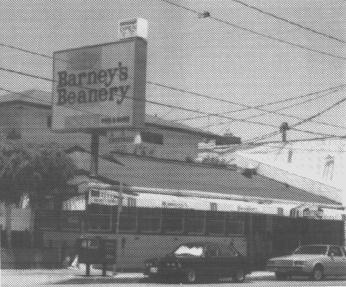 |
Let us leave Barney's Beanery and walk across the street, follow Santa Monica Boulevard on the
righthand side and stop at the next street corner. On the other side of the road you can see "Al & Ed's
Autosound". In Morrison's time it used to be called The Extension, a topless bar with a
dancefloor, where Jim liked to meet with journalists. He had been amused by the fact that the reporters
would be distracted and confused by the waitresses and dancing girls. The famous "Rolling Stone"-interview with Jerry Hopkins was done in there.
Let us walk a little bit on the lefthand side down La Cienega Boulevard. We come across a Spanish-style building, which today belongs to the Ohlmeyer Communications Company (962 La Cienega
Boulevard). In earlier times the Elektra Sound Recorders Studio used to be situated here,
where The Doors recorded the albums "The Soft Parade" and "Morrison Hotel". Direct
entry to the studio was through the dark brown wooden door adjacent to the main building.
Crossing the street, the way leads directly to a one-storey building with a yellow billboard
attached to it saying "Mahin Oriental Rugs" (947 La Cienega Boulevard). The room next to the entrance
door, both decorated with iron bars, is where Pamela Courson's boutique Themis used to be,
which Jim Morrison had financed for her and which she had run for about 3 years. Walking up the stairs
behind the front door, one will get to a balustrade which leads directly to a door with the letter K. Behind
this door the HWY Office used to be situated, which Jim Morrison had rented in order to
prepare and process his film HWY, together with Frank Lisciandro and other co-workers.
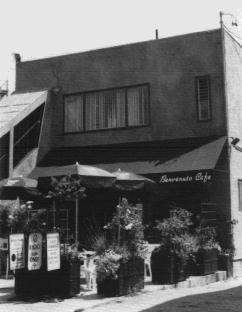 |
Let us again walk down La Cienega Boulevard up to the "Al & Ed's Autosound" and turn left into
Santa Monica Boulevard. After a few yards one will see a boxshaped red building on the left. Today it is
called the Benvenuto Café. Before this was called "The Center" and served as the office of a gay &
lesbian community centre. Up until 1972 it was painted yellow, had a different type of staircase and was
the Doors Office (8512 Santa Monica Boulevard). This is where The Doors and Bill Siddons
did their paperwork; this is where Kathy Lisciandro worked as Jim Morrison's secretary; this is where
Danny Sugarman answered the fan mail. The group's rehearsal room was situated on the lower floor,
where the sessions and recordings for the album "L.A.Woman" took place between October
1970 and February 1971. After The Doors moved out in 1972, the building remained a sound studio and
was called "The Upside Down Studio" until 1985. After renovation of the staircase the gay & lesbian
community centre moved in. |
| Walking a little further up Santa Monica Boulevard, one will discover a bar called The
Palms (8572 Santa Monica Boulevard). Jim Morrison had sat inside this bar numerous times, used
to take a little snack here and drank beer and whiskey during the breaks between rehearsals. |
 |
We are now crossing Santa Monica Boulevard and follow the road down towards the left. Soon
we arrive at the Troubadour (9081 Santa Monica Boulevard). This is the club where Jim saw the
comeback of the Smothers Brothers. After a booze-up with Babe Hill, Jim Morrison was barred from this
club. It is the same club where once upon a time John Lennon and Harry Nilsson got totally drunk and
ended up being kicked out. Today the Troubadour exclusively presents Punk and Heavy Metal
bands.
 |
Let us turn right again, walking back down Santa Monica Boulevard, and after a few steps we
reach an arch-like block of flats in the shape of a horse shoe called "New Orleans Square". Only a few
years ago the Tropicana Motel as well as Duke's Coffee Shop were situated in this
building complex (8585 Santa Monica Boulevard). Between 1966 and 1969 Jim used to live in this
motel, with a few short interruptions. He regularly used to have breakfast at Duke's Coffee Shop. The
Tropicana Motel was dissolved, and Duke's Coffee Shop moved into the same building as the Whiskey A
GoGo. |
Only a few yards further, at the junction of Santa Monica Boulevard/La Cienega Boulevard, is a
supermarket called Monaco Liquor (8513 Santa Monica Boulevard). This is where The Doors
used to buy their drink supplies during rehearsal breaks. Jim Morrison used to exclusively purchase his
alcohol here, as the supermarket was only a minute away from Jim's motel room and the Doors Office.
The exterior of the supermarket has since then hardly changed.
A few further steps lead to a dark brick building, in which the florist "Leo's Flowers" resides
today (8505 Santa Monica Boulevard). At the time of The Doors this place used to be the Phone
Booth, another topless bar where The Doors liked to hang out. In one scene of HWY the neonlights
of the former Phone Booth are easily recognised.
| Directly adjacent to "Leo's Flowers", at # 1005 La Cienega Boulevard, is the Alta Cienega
Motel. This is where Jim Morrison lived, with short interruptions, on the first floor, room No. 32,
between 1968 and 1970. His window is situated directly above the driveway. Right next to it is some sort
of balcony on which scenes for HWY were shot. If you are lucky you can rent room No. 32. Another
scene for HWY was shot in the tiny bathroom, which also has not changed until today. If you look
carefully, you can see writings underneath the new paintwork. However, the motel was kept in green in
Jim Morrison's time, and it surfaces in some of his poems, as well as in "The Celebration Of The
Lizard", as the "green hotel". You can also see the small reception in HWY where Jim used to pick
up his post, as well as the telephone in the courtyard of the motel, from which Morrison used to lead
ordinary phone calls (however, in those times it used to be a phone booth). |
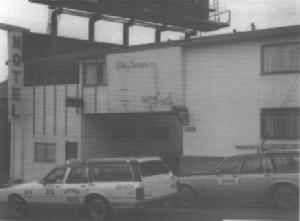 |
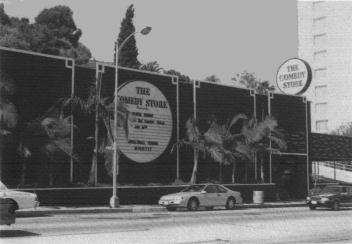 |
Let us leave the Alta Cienega Motel and walk uphill La Cienega Boulevard to the junction of
Sunset Boulevard. Crossing the road and turning right, you can see the building where The
Kaleidoscope (8433 Sunset Boulevard) used to be. The Doors played here on April 21-23, 1967.
Today the place is called "The Comedy Store". |
|
After about 1 kilometre one can see the Hyatt
Hotel (8401 Sunset Boulevard) and shortly after this the Chateau Marmont on the
lefthand side (8221 Sunset Boulevard). Jim used to live in both of these hotels for only a relatively short
time between November 1970 and March 1971. At the Chateau Marmont he fell off the balcony on the
righthand side of the hotel onto one of the "cottages" in the garden below, and broke two of his ribs. At
the Hyatt Hotel (which Robby Krieger jokingly describes as "Riot Hotel") Jim hung off a balcony on the
10th floor until someone called the police and they had to talk him into coming back up into the
room. |
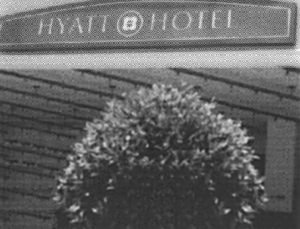 |
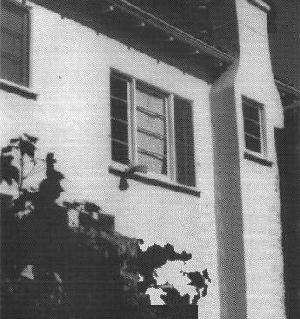 |
Let us now leave Sunset Boulevard and follow Sweetzer Avenue downhill until we find
Norton Avenue on the left.In building complex No. 8216 we can see the apartment where
Pamela used to reside on the second floor of the inner courtyard. It was also Jim Morrison's last Los
Angeles address before his departure for Paris. One scene from Danny Sugarman's book "Wonderland
Avenue" is based here. Whenever Pamela was out of her mind with rage, she used to throw all of Jim's
books, and other things, out of the window. |
| Let us follow Sweetzer Avenue back to Sunset Boulevard and turn left. After a while you come
past a bookshop called Booksoup. Walk through the backdoor and notice a long, green (it used to be
grey some years ago) and old building. This used to be the former cinema called Cinematique
16, where Jim Morrison read his poetry during a Norman Mailer Benefit on May 30-31, 1969.
Accompanied by Robby Krieger, the song "Far Arden Blues" was recorded during this event. It
was later published on the album "An American Prayer". |
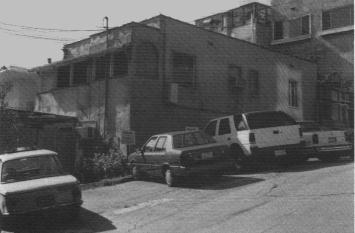 |
Go out of the bookshop again and cross the street. Check Tower Records, which is in front of you -
Ray Manzarek usually buys his records in there.
 |
About 150 metres further on to your left you'll reach the Whiskey A GoGo (8901 Sunset
Boulevard), which has in the meantime been painted red again. The Doors were the houseband here from
May to August 1966 and played one or two gigs almost every night. The interior of the Whisky has
hardly changed since then. On the righthand side one will find the staircase leading up to the dressing
rooms. This is where Jim met Pamela Courson during one of his numerous concerts. One of the owners
of the club, Mario Magliani, is still happy to play the bouncer today, and loves to talk about the good old
times. |
Situated in the same building today is Duke's Coffee Shop, where one should have coffee and
watch a variety of musicians milling about. With a little luck one could bump into Danny Sugerman, who
sometimes eats breakfast here. A Morrison poster decorates the wall, amongst countless signed
photographs of other bands. In the old days the room (where Duke's Coffee Shop is now) was the club
called the London Fog, where The Doors were permanently employed as resident band, and
where during endlessly long nights they developed their typical Doors sound.
The Whiskey's exterior was returned to its original state for the shooting of the Doors film. For
Oliver Stone's "The Doors" the club opposite the street (The Central) was the fake "London
Fog". Today the club is called the Viper's Room.
|
Adjacent to the Central is a small supermarket with the name of Terner's Liquor Deli. In the old
days it was called Turner's Liquor, where The Doors used to buy their alcohol supplies during
each set's break (at first the Whiskey did not have a licence to sell alcohol). On the same side and not far
from Terner's Liquor Deli there is the huge 9000 Building (9000 Sunset Boulevard). On top of
that building Jim Morrison balanced on the railing for the final scenes of his film HWY. |
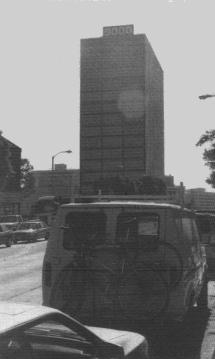 |
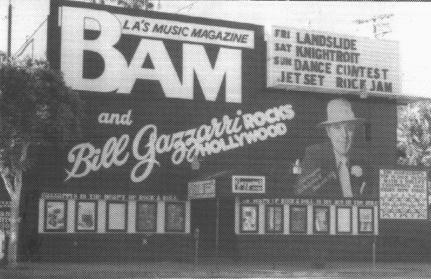 |
We are now crossing Sunset Boulevard again and follow it down on the left hand side. In very
close proximity to each other, we can find three music clubs here: Gazzari's (today it is called
Billboard Live), where The Doors played several gigs from the end of January 1967 to March 1967. |
| The Roxy, where Robby Krieger played a few concerts in the 70s; and The Rainbow.
The Doors cover band Wild Child plays at all three clubs regularly, and the L.A. Doors tourist should try
seeing them play at one of these places if one is interested in cover bands. Sometimes Robby Krieger
joins them on stage. |
 |
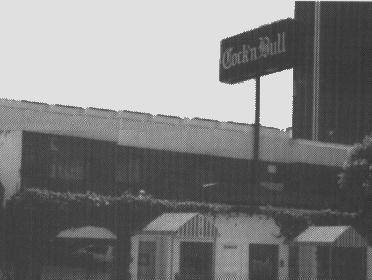 |
The Cock'n'Bull (9170 Sunset Boulevard), where Jim Morrison often used to eat, is situated
approximately 1 km further down on the left hand side. After one of these meals in the winter of 1970,
while in a slightly drunken state, Jim pretended to be a matador with his jacket in the middle of Sunset
Boulevard, with the passing cars acting as the attacking bulls. I heard that the Cock'n'Bull does not exist
anymore. |
For the next part of the "Doors Memorial Tour" you will need a car, or you can take one
of the unreliable buses, as the sights are too far apart from each other to be able to reach them on
foot. These are listed as follows:
Sunset Sound Recorders (6650 Sunset Boulevard): The Doors recorded their first two
albums here. It is a beige brick building, not recognisable as a studio from the outside. The main entrance
is in the backyard.
| Aquarius Theatre (6230 Sunset Boulevard):Today this large hall is called "Star Search
Theatre" and is used for talent shows. In the old Aquarius The Doors recorded three live gigs for
"Absolutely Live" on July 21 and 22, 1969. In the 60s the building used to belong to various
owners, who always changed its name. The Doors often played at this venue, which in their time was
also called Hullabaloo and Kaleidoscope. |
 |
Hollywood Bowl: The famous open-air theatre can easily be found if one drives up north on
Highland Avenue. One can hardly miss the entrance to the Bowl. From early morning onwards one can
visit the theatre free of charge and is allowed to run around on the stage. On July 5, 1968 The Doors
gave a legendary concert here, which has already been immortalised on video.
Griffith Observatory: The Observatory is situated at the edge of Griffith Park, and is easily
reached via Vermont Avenue which leads to Vermont Canyon Boulevard. Jim Morrison fans should take
their copy of "The Illustrated History" along with them, as a series of pictures contained in this
were taken here. Some of them are printed the wrong way round; however, for the trained eye it should
not be difficult to find the corresponding places.
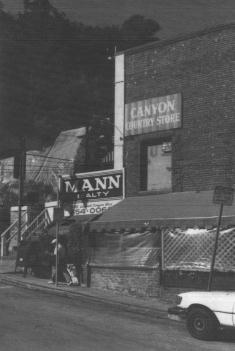 |
Love Street: The street's real name is Rothdell Trail, which is a small side street
branching off the beginning of Laurel Canyon Boulevard, and rejoining it after approximately 2
kilometres. The best thing is to drive up north on Laurel Canyon Boulevard up to the Canyon Country Store and park there (2108 Laurel Canyon Boulevard). |
 |
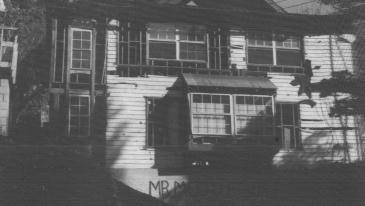 |
Jim not only immortalised this store
in the song Love Street ("... there's a store where the creatures meet, I wonder what they do
in there..."), but also house # 8021 Rothdell Trail, which is nestled up against the mountain
slope, only a few metres away from the store ("... she has a house and garden..."). Jim and
Pamela lived on the top floor of the woodpanelled building. For a long time it was very run down and
neglected, but the lawyer owning the house, a Doors fan herself, sold it to a fan, who totally restored the
house during the past years. Someone had sprayed "Mr Mojo Risin" on the concrete wall that
serves the building as a support pillar, but that had been wiped off some years ago. ... |
| To find the house that Ray Manzarek owned in Wonderland Avenue, where he
rehearsed with his band after The Doors (address unknown), you will need a map that will lead you
through the maze of tiny streets in Laurel Canyon. Wonderland Avenue also gave Danny Sugarman's
book its name. Also on the left side of Laurel Canyon Boulevard is Lookout Mountain Avenue,
where John Densmore and Robby Krieger used to share the house # 8826. This house was also Jim's
permanent address in the year 1966. At the lookout point above the house Jim Morrison wrote the song
People Are Strange. On top of the actual Lookout Mountain the late Doors producer Paul
Rothchild used to live in a big house. |
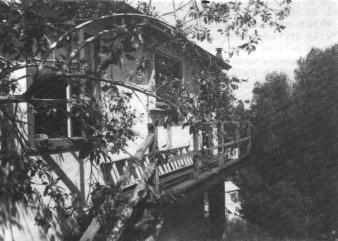 |
Downtown L.A.:
 |
Morrison Hotel (1246 Hope Street): Morrison Hotel is in downtown L.A., a dirty and dangerous area.
Today the large multistorey building is a hotel again. Ray Manzarek accidentally "discovered" the
Morrison Hotel at the end of 1969. The next day The Doors went there, together with photographer
Henry Diltz, where he shot a series of photos. The famous window used to be on the left hand side
directly adjacent to the entrance, where photos printed in "The Illustrated History" were also
shot. The entrance decorated with mosaic ornaments still exists. On the outer wall one can also still
recognise the non-functioning neon sign of the hotel. See many great photos of The Doors inside and
outside the hotel on Henry Diltz's CD-ROM "Under The Covers". |
| Hard Rock Cafe (300 5th Street): The original Hard Rock Cafe, which is immortalised
on the backcover of the album Morrison Hotel, is not a café anymore but closed down years ago.
The site is still there. The "new" Hard Rock Café in Los Angeles has nothing in common with the
original, apart from its name. The area is not safe, be careful! Great shots of The Doors inside and
outside the cafe can be seen on Henry Diltz's CD-ROM "Under The Covers". |
 |
Santa Monica:
Olivia's (2615 Main Street): This restaurant in Santa Monica inspired Jim Morrison to write the song
"Soul Kitchen". Here you could eat reasonably priced dishes from the southern states of the
U.S.A., which the students from the UCLA were also able to afford. In his biography, John Densmore
wrote a whole chapter about Olivia's. In its place today is the "Zuma Jay Surf Shop".
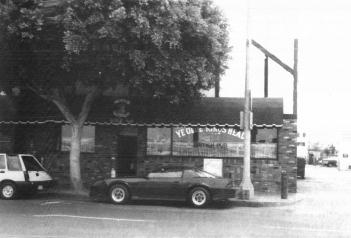 |
Turkey Joint West (116 Santa Monica Boulevard): Rick and the Ravens played at this
club as resident band from the beginning of June to the end of April 1965. In here, with this band, Jim
Morrison made his first public appearance on June 5, 1965. Today this long-stretched, narrow club
situated near the beach is a beautifully decorated English pub called "Ye Olde King's Head". |
Santa Monica Municipal Pier: The pier leads from the beach to deep into the ocean, resting
on strong tree trunks. Not only the famous song "Under The Boardwalk" originates here, but
also several well-known promotion photos of the Doors by Henry Diltz. He who searches, will find the
spot where the photos were taken (find beautiful outtakes of this location on Henry Dilz's CD-ROM
"Under The Covers".
Cheetah (1 Navy Street): The Cheetah, a concert hall known in the 60s for its psychedelic
music, was destroyed by fire in 1979. Today there is nothing but sand in its place. Before it was renamed
Cheetah, it used to be the "Avalon", which was the home to many 50's Rock'n'Roll stars.
| Santa Monica Civic Auditorium (Pico Boulevard/Main Street): The Doors played here on
July 3, 1967. |
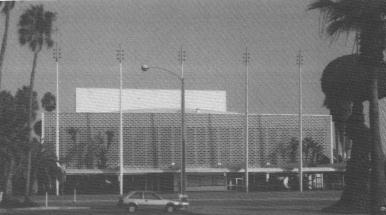 |
Venice:
 |
Small pedestrian bridge (Carroll Avenue/Alberta): Bobby Klein took some photos of the band here
during a walk through Venice. |
| Jim Morrison mural (1811 Speedway):
This huge painting of Jim Morrison in Venice is one of the main sights you should visit there. In shops
you can buy postcards showing the mural. |
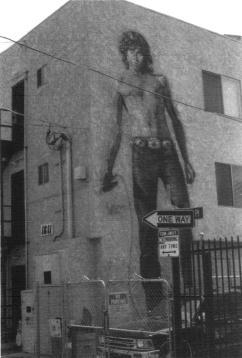 |
The Morrison (at the corner of Speedway and Westminster):
This was the building in which Jim's friend Dennis Jacobs had an apartment. On the roof Jim Morrison
wrote songs like "My Eyes Have Seen You" and most of the songs for the first and second
Doors album. He also wrote most of his early poetry here.
Ocean Front Walk:
Watch two short super-8-movies filmed by Henry Diltz of The Doors walking along this famous street
next to the beach on his CD-ROM "Under The Covers". Scenes filmed on Ocean Front Walk are
also to be seen during Jim Morrison's film "HWY". In the beginning of Oliver Stone's "The
Doors", Val Kilmer is following Meg Ryan across Ocean Front Walk.
Hollywood:
108 N. Sycamore Avenue: In this small house, almost hidden by a huge rubber tree, Pamela
Courson died of a heroin overdose in her apartment on the right side of the ground floor on April 25,
1974.
TTG Studios (1441 N. McCadden Place) The Doors recorded their third album "Waiting
For The Sun" here. Today the building is called "Shooting Star International".
Westwood:
 |
Village Recorders (1616 Butler Avenue): This is the studio where Jim Morrison did his
poetry session on 8th December 1970 with the help of recording engineer John Haeny. Some of that
session got published on the album "An American Prayer". Very close to the studio was the
Lucky "U" (Santa Monica Boulevard, right behind Santa Monica Freeway). It was a restaurant
frequently used by Jim and his friends. It was torn down to make place for an Exxon gas station. |
Santa Ana:
| Fairhaven Cemetery (16572 E. Fairhaven, Santa Ana): If you thought that Pamela Courson,
Jim's longstanding girlfriend, was (as at first planned) buried in the same grave as Jim at Pere Lachaise,
you were wrong. Pamela was cremated at the Forest Lawn Cemetery Crematorium and her ashes were
installed in their resting place at Fairhaven Cemetery on July 18, 1974. If you want to pay Pamela a visit,
please ask at the cemetery office for directions to her resting place (in the Garden Courts of the
cemetery, Box 164). Pamela's urn is behind a bronze plate in one of the compartments of the
crematorium. Her real name (Courson) is not written on the plate. Instead it carries the name
"Morrison, Pamela Susan". The grave is also registered under this name at the cemetery
office. |
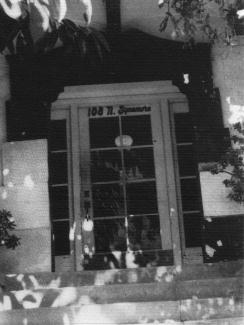 |
Topanga Canyon:
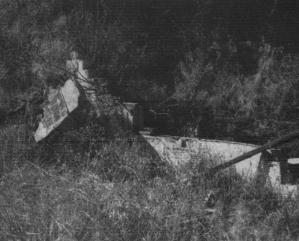 |
Topanga Corral (2034 Topanga Canyon Boulevard): This was the restaurant the song
"Roadhouse Blues" was all about. It was destroyed by a big fire a long time ago. At the back of
the restaurant there was the small cabin Jim Morrison had bought for Pamela Courson - he called it
bungalow in the song. Today there might be an apartment block. I summer 1993 I found the remains of
the cabin: bricks, pieces of wooden window frames and some dry old blue paint. |
OTHER LOCATIONS:
| Shrine Exposition Hall (700 West 32nd Street): located round the block of the Shrine
Auditorium (665, West Jefferson). The Doors played four concerts here on December 22 and 23,
1967. |
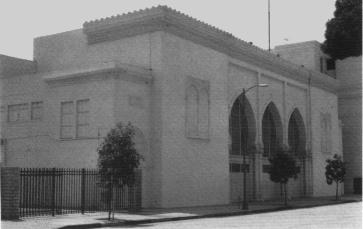 |
 |
The Forum (Manchester & Prairie): The Doors performed here on December 14, 1968
at the peak of their carreer. Today it is called Great Western Forum. |
| The Doors' billboard (at the Western corner of Sunset Boulevard/Laurel Canyon
Boulevard): Opposite the new Virgin megastore was the location of the huge Doors billboard for their
first album. It said "Break On Through With An Elektrifying Album". Check your copy of
The Illustrated History, page 26, 82 and 83. |
 |
There are a few further clubs that do not exist anymore today, and others are, as they were then,
private properties today. The Doors gave concerts in all of these:
| Bido Lito's (107 N. Ivar Drive, Hollywood) |
Will Rodgers State Park (14400 Sunset Blvd, Hollywood) |
| Warner Playhouse (755 N. La Cienega Blvd, West Hollywood) |
Brave New World (1644 N. Cherokee Avenue, Hollywood) |
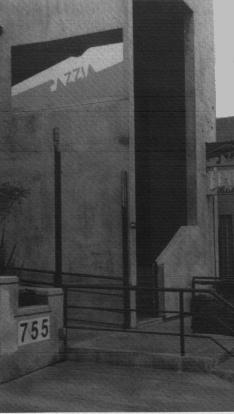 |
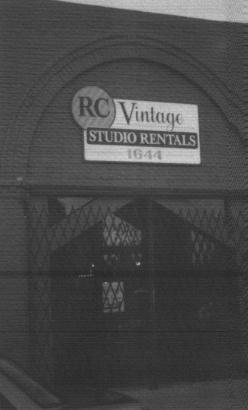 |
| The Seawitch (8514 Sunset Blvd, Hollywood). This is now grey concrete building. |
|
There are a few places missing in this guide: PLEASE HELP!
Most importantly, the address of the band's third rehearsal room at a beach south of Washington
Boulevard (remember the photos in "The Illustrated History" with the coloured windows in the
background) is missing. There's just one house which might probably the one. It has no colored windows
anymore, but the wood seems to be the same, and there is a big room on the ground floor. It is located at
the corner of Speedway and 26th Avenue. The address is Ocean Front Walk 26005; it's hidden behind
trees and plants. My friend Yaëlle found out this one, but confirmation is still needed. Is anyone brave
enough to knock at the door?
Further indications to the house behind a Greyhound Coach station owned by a certain Hank
Olguin, where the band also used to rehearse, is still needed. I would welcome any help from you as to
these missing links.
Thanks for invaluable help to Ulrich Michaelis, Yaëlle Bolender, Frank Lisciandro, Ray
Manzarek, Dorothy Manzarek, Sybille Nova, Danny Sugerman, Jeannie Cromie, Stefanie Toenges,
Gregg Shaw and a few others I forgot to mention.
|
|



